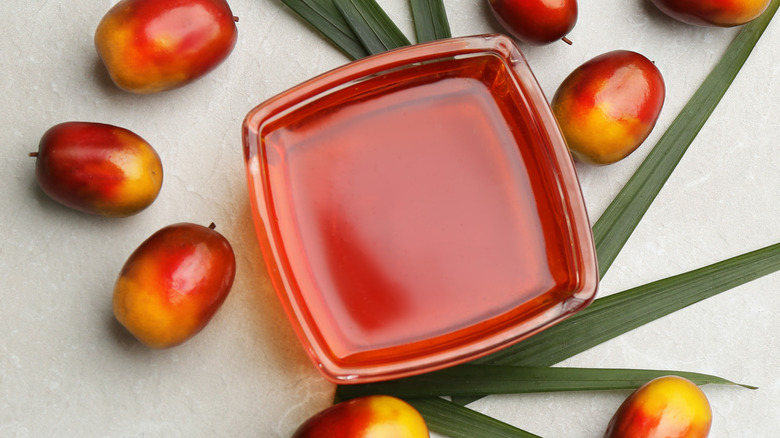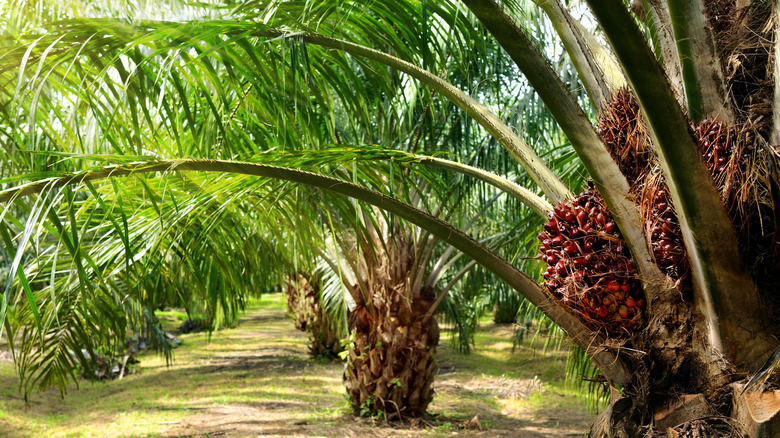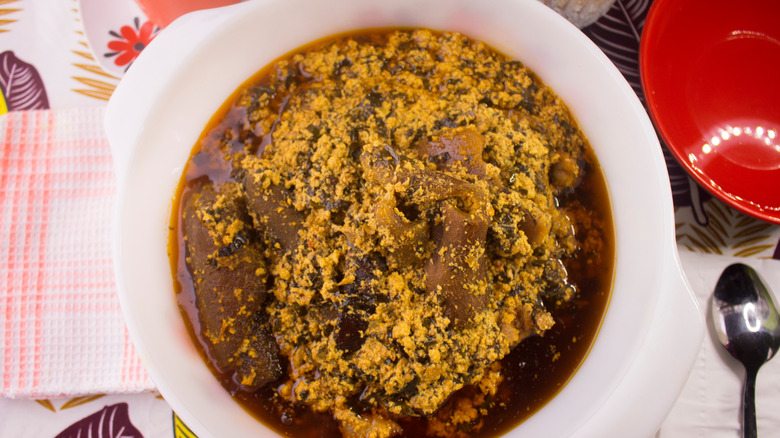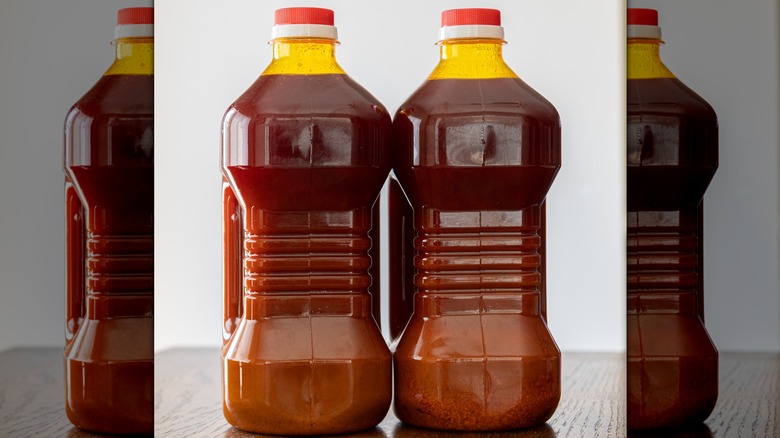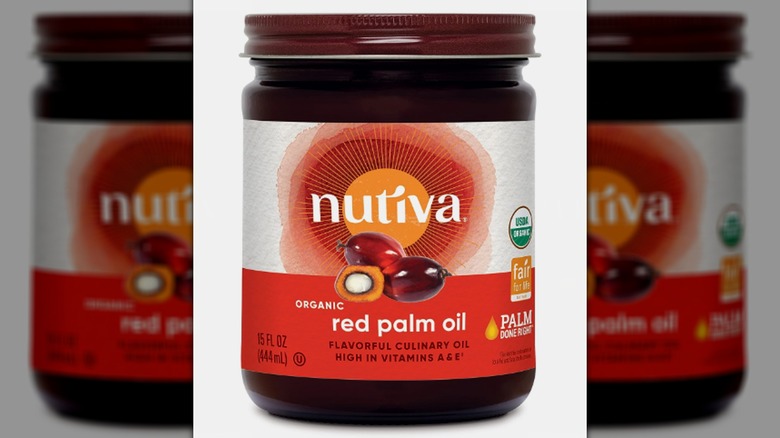What Is Red Palm Oil And How Is It Best Used?
If you've ever perused the ingredient list of your favorite shampoo, concealer, sunscreen, or even laundry detergent, palm oil may be a common component. Native to western Africa, the oil palm has been put to use by people for thousands of years. The oil from its fruit was traditionally used to light street lamps in the ancient Kingdom of Benin, is included in black soap made by the Yoruba people, and continues to be consumed for medicinal purposes in some places, although there is little proof of its efficacy in treating disease.
However, red palm oil's primary use is as food. It's an ingredient used globally in many dishes. Around 100 years ago, the oil palm trees – Elaeis guineensis – were brought to the southeastern region of Asia, eventually making it to Indonesia and Malaysia, now the top producers of palm oil. And palm oil remains a notable ingredient in traditional West African dishes like jollof rice and efo riro.
Palm oil has a deep red color, thanks to carotene, though it can also appear more orange or yellow. It typically comes in a semi-solid consistency, similar to coconut oil, that melts into a burnt orange color when heated up. While it has a slightly pungent, nutty smell, palm oil is fairly mild in flavor. Though if you're not used to it, you may taste it in dishes that have been cooked using it.
How is palm oil made?
Palm oil is derived from the fruit that hangs in bunches on the oil palm tree. The individual oval-shaped fruits, which grow together by the hundreds, are around one to two inches in diameter. They have a white kernel inside, but red palm oil comes from the pulp that surrounds it, and the hard external layer.
Once the clusters are cut down by farmers, they're transported in a truck to a processing facility where the palm oil is made. The clusters are tossed into a machine that separates the individual fruits from the branch, which is discarded as the palm fruits continue their journey. To make extracting the oil easier, the fruits are steamed at high temperatures to soften the outer layer.
As the fibers within the fruit are tossed out, the flesh is pressed, producing crude palm oil. While the crude oil can be used for cooking, it's often filtered and diluted in order to clarify the palm oil. The clarified oil is dubbed as pure palm oil and has a light off-white color, like coconut oil.
What are the environmental effects of palm oil?
For people who didn't grow up cooking with red palm oil, their first introduction to the ingredient may have been via discussions on how bad it is for the environment. According to the WWF, palm oil is found in around half of the packaged products bought in stores. Not only is the oil affordable, but its lack of trans fats makes it a viable addition to processed foods.
Yet the high demand for it has had less than stellar effects. In countries that supply much of that demand, where the oil palm tree is not native, such as Indonesia, Malaysia, and Papua New Guinea, palm oil farming has caused deforestation. Many countries in South America also contribute to the problem. Over the course of 20 years, a scientific study showed that the industry was responsible for around one-third of deforestation on 25 million acres of land in Indonesia. However, the harmful environmental effects have recently been slowing down.
Still, that fact fails to eradicate the detrimental effects the palm oil industry has caused in places where forests have been destroyed in order to make room for a monoculture of oil palm plantations. With palm oil being in a vast amount of goods, avoiding it is almost impossible. Plus, there are people who have used the oil for thousands of years and make their livelihoods by farming it — palm oil's popularity won't be waning any time soon.
How can you cook with palm oil?
While palm oil has a somewhat strong odor, the taste is quite mild, with an earthy flavor. The most notable trait of palm oil is its deep red hue. In many African countries, it is used to color foods like egusi soup or plantain porridge. Aside from livening up a dish, crude palm oil enhances the already rich, nutty flavors found in various African and Asian cuisines. It can be drizzled on top of broiled yam, plantain, cocoyam, or cassava.
Palm oil is used just like any other cooking oil. It can be poured onto vegetables before roasting or added to a marinade for poultry, meat, and fish. When cooked, the oil is typically heated along with onions, garlic, herbs, and warm spices as a base for soups and stews.
If you're trying out the oil for the first time and only want to use a small amount, it combines well with other neutral cooking oils, like canola or peanut oil. With its high smoke point of about 450 degrees Fahrenheit, palm oil can be used to sauté vegetables, pan-fry meat and fish, or roast nuts.
What are the benefits of using palm oil?
Composed of leafy greens, fruits, nuts, and whole grains, the African diet is underrated when it comes to being health-conscious. Palm oil is an ingredient in this diet and is both high is high in vitamin E, as well as being able to increase the amount of vitamin A that people absorb. It's considered to be an antioxidant-rich oil.
Palm oil also has significant amounts of tocotrienols, which may decrease the risk of stroke and dementia progression. A study on mice found improved cognitive function after being given mixed palm oil tocotrienols, and a study on people found a slight benefit in slowing the growth of brain lesions.
The oil has zero trans fats, which are known to have an adverse effect on cholesterol. However, like any food, red palm oil also has its downsides. What it lacks in trans fats, it makes up for in saturated fats, an unhealthy fat that causes weight gain and an increased risk for heart disease.
The oil is around 49% saturated fat. When compared to other cooking oils, palm oil is healthier than coconut oil, which is made of 85% saturated fat. However, extra virgin olive oil, which has only 1.9 grams of saturated fat, is still a superior choice for your overall health.
Where can you find palm oil?
Since palm oil is mainly eaten across Africa, and in some Asian and South American countries, it's probably easiest to find it in stores that specialize in those foods. If you live in a larger city or suburban area, it might be easier to find one of these specialty stores near you. Palm oil should be in an aisle with other cooking oils.
If there are no African or Asian grocery stores in your area, Whole Foods carries unrefined red palm oil. However, it only stocks one brand, so your options will be limited. Walmart carries a selection of palm oils online, but it taps other retailers to sell the product. Instead of using a middleman, go directly to online retailers of African and Asian goods to choose from a wide array of palm oils. Online stores like OsiAfrik, African Food Supermarket, and Africa's Flavour carry an assortment of palm oils for all your cooking needs.
Oil palm trees are grown in countries that maintain a warm climate all year, so palm oil will never be out of season. It can last for over a year, especially if it's refined. However, if your palm oil has gone bad, it will have a sour or metallic taste and smell that indicates that it needs to be tossed.
